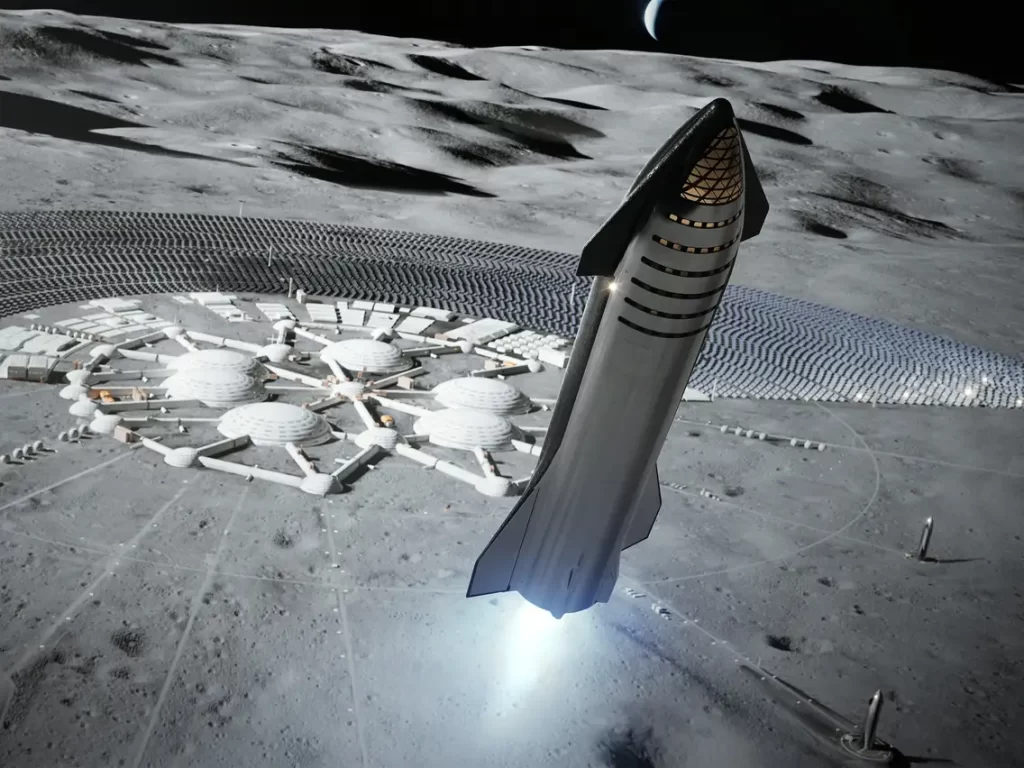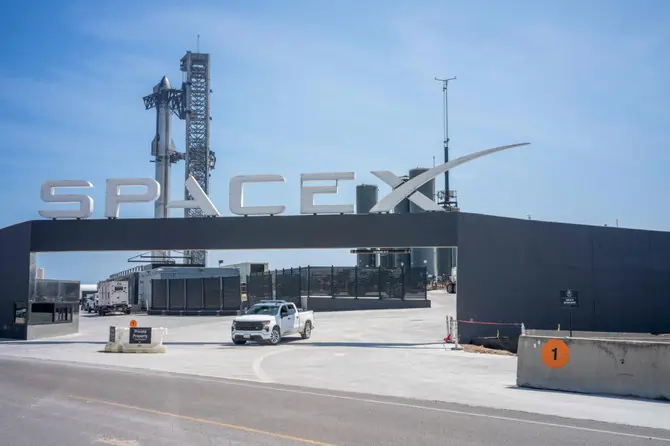SpaceX’s $3 billion Starship rocket’s third launch, the pioneering aerospace company founded by Elon Musk, is set to achieve another milestone today with the third launch of its ambitious Starship rocket. In this blog post, we’ll take a closer look at what makes this launch significant, the technology behind the Starship, and the implications for the future of space exploration.
Table of Contents
Unveiling the Beast: Understanding the SpaceX Starship Rocket
SpaceX’s Starship is a revolutionary launch vehicle currently under development. It has the potential to be a game-changer in space exploration, aiming to carry humans and cargo to the Moon, Mars, and beyond. Let’s delve into what makes this behemoth of a rocket so unique:

A Two-Stage Powerhouse:
Starship consists of two reusable stages:
- Super Heavy Booster: This massive first stage acts like a workhorse, providing the initial thrust to overcome Earth’s gravity. Powered by a cluster of Raptor engines, it’s designed to land back on Earth after launch, much like the Falcon 9 boosters.
- Starship: This upper stage acts as the spacecraft, capable of carrying crew or cargo. It houses the living quarters for astronauts on deep space missions and has its own Raptor engines for maneuvering in space and landing on the Moon or Mars.
Size Matters:
Standing at a staggering 394 feet (120 meters) tall, Starship is the largest and most powerful launch vehicle ever developed, surpassing even the Saturn V rocket used for Apollo missions. This immense size allows it to carry a significant amount of payload:
- Cargo: Up to 150 metric tons of cargo in its fully reusable configuration.
- Crew: Starship can transport crews of up to 100 people, paving the way for large-scale space colonization efforts.
Full Reusability – A Game Changer:
One of Starship’s most significant features is its complete reusability. Both the Super Heavy booster and Starship are designed to return to Earth and land vertically, minimizing launch costs significantly compared to traditional expendable rockets.
Taking Flight to Other Worlds:
Starship’s capabilities extend beyond Earth’s orbit. Here’s a glimpse of its potential missions:
- Lunar Lander: NASA has chosen Starship to land the first astronauts back on the Moon as part of the Artemis program.
- Martian Dreams: Starship is a key component of SpaceX’s ambitious plan to establish a human colony on Mars. Its ability to carry large payloads and crew makes it well-suited for long-duration missions to the Red Planet.
- Beyond the Solar System: The sheer power of Starship could enable missions to explore deeper into our solar system and potentially even beyond.
Current Stage of Development:
Starship is still under development, with ongoing testing and refinement. SpaceX has conducted several successful high-altitude test flights, with the most recent occurring in March 2024 (at the time of writing this).
The Future of Space Exploration:
Starship holds immense potential to revolutionize space exploration. Its reusability, power, and capacity could significantly reduce launch costs and open up new possibilities for deep space exploration. As development progresses, the success of Starship will be closely watched by the spacefaring community, as it could usher in a new era of human presence beyond Earth.
Also Read – Understanding Google Merchant: Exploring Product Limits
Significance of the Third Launch of SpaceX Starship
The recent third launch of the SpaceX Starship in March 2024 was a significant milestone for the program, marking several key advancements:

- Booster Reusability Confirmed: The successful return and landing of the Super Heavy booster solidified the concept of full reusability. This achievement is crucial for cost-effectiveness, a major advantage of Starship compared to traditional rockets.
- High-Altitude Flight Test: The launch vehicle reached a suborbital altitude, allowing engineers to gather valuable data on performance at high speeds and atmospheric re-entry. This information is essential for refining the design and ensuring safe operation for future missions.
- Progress Towards Orbital Flight: While not achieving orbit on this test, the third launch paves the way for future attempts that will demonstrate Starship’s capability to reach space. A successful orbital flight will be a breakthrough, opening doors for more complex missions.
- Data for Improvement: Even though the Starship itself didn’t land successfully, the flight provided valuable data on its performance during re-entry and potential causes of the landing failure. This information will be used to improve the design and ensure successful future landings.
- Maintaining Development Momentum: This successful launch signifies continued progress in Starship’s development. It demonstrates SpaceX’s commitment to the program and keeps them on track for ambitious goals like the Artemis missions and potential Mars colonization efforts.
- Impact on Space Industry: The success of Starship has a ripple effect on the space industry. Its reusability and potential for low-cost launches can benefit other companies and organizations looking to access space more frequently and affordably.
However, there are still challenges to overcome:
- Starship Landing: Future launches will need to focus on perfecting Starship’s landing capabilities for both stages.
- Environmental Considerations: The powerful engines and launch processes require careful management to minimize environmental impact.
- Safety Concerns: As with any high-powered rocket, ensuring crew safety during launch and landing remains a top priority.
Overall, the third launch of Starship represents a significant step forward for the program. It demonstrates progress in reusability, and high-altitude flight capabilities, and keeps development on track for ambitious future endeavors. While challenges remain, the potential of Starship to revolutionize space exploration remains highly promising.
Unveiling the Powerhouse: Key Features of the SpaceX Starship Rocket
SpaceX’s Starship is a behemoth of a launch vehicle unlike anything seen before. Here’s a breakdown of its key features that make it a potential game-changer in space exploration:

1. Two-Stage Powerhouse:
- Super Heavy Booster: This colossal first stage provides the initial thrust to escape Earth’s gravity. Powered by a cluster of Raptor engines, it’s designed for a vertical, reusable landing, similar to the Falcon 9 boosters.
- Starship: The upper stage acts as the spacecraft, capable of carrying crew or cargo. It houses living quarters for deep-space missions and has its own Raptor engines for maneuvering in space and landing on planetary surfaces.
2. Unmatched Size:
- Standing at a staggering 394 feet (120 meters) tall, Starship dwarfs most operational rockets. This immense size translates to impressive payload capacity:
- Cargo: Up to 150 metric tons in its fully reusable configuration, enabling transportation of large payloads for lunar or Martian bases.
- Crew: Starship can accommodate crews of up to 100 people, paving the way for large-scale space colonization efforts.
3. Full Reusability – A Revolution:
- A major feature of Starship is its complete reusability. Both the Super Heavy booster and Starship are designed to return to Earth and land vertically, significantly reducing launch costs compared to traditional expendable rockets. This reusability is crucial for making space travel more sustainable and affordable.
4. Powerful Raptor Engines:
- The Raptor engine is the heart of Starship, burning a combination of liquid methane and liquid oxygen to produce incredible thrust. These engines are designed to be reusable and throttleable, allowing for precise control during launch, landing, and in-space maneuvers.
5. Beyond Earth’s Orbit:
- Starship’s capabilities extend far beyond Earth’s atmosphere. Here’s a glimpse of its potential missions:
- Lunar Lander: Starship is NASA’s chosen vehicle for landing astronauts back on the Moon as part of the Artemis program.
- Martian Dreams: Starship is a key component of SpaceX’s ambitious plan to establish a human colony on Mars. Its ability to carry large payloads and crew makes it well-suited for long-duration missions to the Red Planet.
- Deep Space Exploration: The sheer power of Starship could enable missions to explore further into our solar system and potentially even beyond.
6. Still Under Development:
- Starship is an ongoing project with continuous testing and refinement. While several successful high-altitude test flights have been conducted, development is still in progress.
7. The Future of Space Travel:
Starship holds immense potential to revolutionize space exploration. Its reusability, power, and capacity could significantly reduce launch costs and open doors for more frequent and affordable missions. As development progresses, Starship is poised to usher in a new era of human presence beyond Earth.
Unveiling the Magic: Technology Behind the SpaceX Starship
SpaceX’s Starship is a marvel of engineering, pushing the boundaries of space travel. To achieve its ambitious goals, it relies on a combination of cutting-edge and proven technologies:

1. Raptor Engine:
- The heart of Starship’s power is the Raptor engine. It’s a full-flow staged combustion engine that burns a combination of cryogenic liquid methane (CH4) and liquid oxygen (LOX) for exceptional thrust.
- Key Advantages:
- High Performance: Raptor engines boast an impressive thrust-to-weight ratio, providing the power needed to lift Starship’s massive payload.
- Reusability: Unlike traditional rocket engines, Raptor engines are designed to be reused multiple times after launch and landing. This significantly reduces launch costs.
- Methane Power: Liquid methane fuel offers several advantages:
- Availability: Methane is a relatively abundant resource that can be produced from various sources, including on Mars.
- Clean Burning: Compared to traditional propellants, methane burns cleaner, reducing environmental impact.
- Throttleability: Raptor engines can adjust their thrust level, allowing for precise control during launch, landing, and in-space maneuvers.
2. Super Heavy Booster:
- The powerful first stage of Starship, Super Heavy, relies on a cluster of Raptor engines to provide the initial thrust needed to escape Earth’s gravity.
- Challenges and Solutions:
- Thrust Management: Controlling the immense thrust of multiple Raptor engines during launch requires advanced software and flight control systems.
- Heat Management: The intense heat generated by the engines necessitates robust heat shielding for both the booster and launch pad.
3. Starship Spacecraft:
- The upper stage, Starship, houses the crew or cargo and is equipped with its own set of Raptor engines for maneuvering in space and landing on planetary surfaces.
- Key Technologies:
- Stainless Steel Construction: Starship’s primary structure is made of stainless steel, chosen for its strength, affordability, and heat resistance.
- Heat Shield: A critical component for atmospheric re-entry is the heat shield, which protects the spacecraft and crew from the scorching temperatures encountered during descent.
- Life Support System (for crewed missions): Starship will incorporate a closed-loop life support system to provide a sustainable environment for astronauts on long-duration space missions. This system will recycle air, water, and waste to sustain the crew.
4. Advanced Avionics and Software:
- Starship relies on a sophisticated suite of avionics and software for control, navigation, and communication. This includes:
- Guidance and Navigation Systems: These systems ensure Starship follows the planned trajectory during launch, orbital maneuvers, and landing.
- Flight Control Systems: These systems maintain Starship’s attitude and stability during flight.
- Communication Systems: Starship needs reliable communication systems for exchanging data with ground control and other spacecraft.
5. Rapid Prototyping and Testing:
- SpaceX is known for its rapid prototyping and iterative development approach. This allows them to test new technologies quickly, learn from failures, and make improvements in subsequent iterations.
The combination of these advanced technologies positions Starship as a revolutionary launch vehicle with the potential to transform space exploration. As development progresses, overcoming remaining challenges and refining existing systems will be crucial for Starship to fulfill its ambitious goals of reaching the Moon, Mars, and beyond.
Starship’s Launch: A Giant Leap for Space Exploration
The development of SpaceX’s Starship rocket holds immense potential to revolutionize space exploration. Here’s a glimpse into the exciting implications it could have for the future:
Reduced Launch Costs:
- Starship’s reusability is a game-changer. By reflying both the Super Heavy booster and Starship itself, launch costs can be significantly reduced compared to traditional expendable rockets. This opens doors for more frequent and affordable space missions.
Enhanced Access to Space:
- Lower launch costs could lead to a surge in space activity. Private companies, research institutions, and space agencies could all benefit from easier and cheaper access to space, fostering innovation and scientific discovery.
Lunar Exploration:
- Starship is chosen by NASA for the Artemis program, aiming to return humans to the Moon. Its large payload capacity allows for transporting equipment, habitats, and even rovers for lunar exploration and potential base establishment.
A Stepping Stone to Mars:
- Starship is a key part of SpaceX’s ambitious plan for Martian colonization. Its ability to carry a large crew and supplies makes it well-suited for long-duration missions to the Red Planet. Starship could be used to establish the initial human presence on Mars, paving the way for further exploration and potential colonization efforts.
Beyond Our Solar System:
- The immense power of Starship could enable missions further into our solar system. It could be used to send probes to explore the outer planets, asteroids, and even interstellar missions in the distant future.
Challenges and Considerations:
- Safety: Ensuring the safety of crew during launch, space travel, and landing remains a top priority. Robust safety systems and rigorous testing will be crucial.
- Sustainability: While methane fuel burns cleaner than traditional propellants, the environmental impact of large-scale launches needs careful consideration and potential mitigation strategies.
- Space Debris: An increase in space activity could lead to more space debris, requiring international cooperation for responsible space exploration practices.
Overall, the Starship program represents a significant leap forward in space exploration capabilities. Its potential to reduce costs, increase access to space, and enable missions to the Moon, Mars, and beyond is truly transformative. As development progresses and challenges are addressed, Starship could usher in a new era of human presence and exploration throughout our solar system and potentially beyond.
The future of space exploration is bright, and Starship is poised to be a major driving force in this exciting new chapter.
Also Read – Unlocking the Power of an Ideal Google Business Profile Post
Common Questions About the SpaceX Starship
Conclusion
The third launch of SpaceX’s Starship rocket marks another exciting milestone in the company’s journey towards revolutionizing space travel. With its innovative technology and ambitious goals, the Starship program has the potential to reshape our understanding of the cosmos and pave the way for humanity’s expansion beyond Earth. As we eagerly await the results of today’s launch, we can’t help but feel optimistic about the future of space exploration with SpaceX at the helm.







